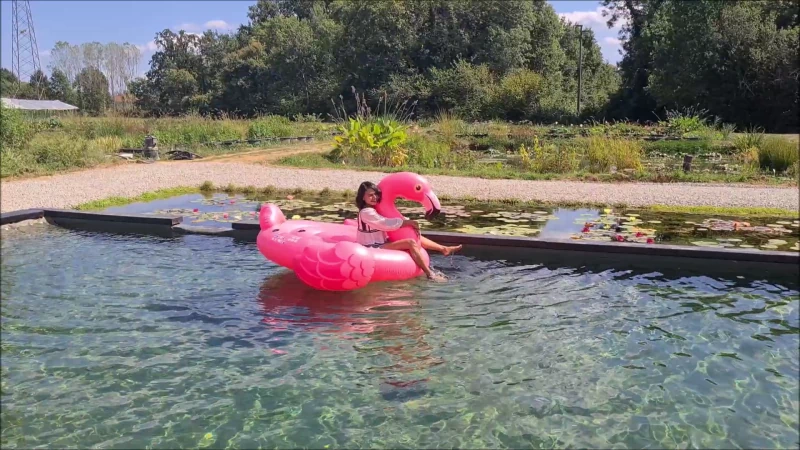
A natural pool or a swimming pond are both somewhere between a pond and a conventional pool.
The aim is to be able to swim in a clean water and in a very beautiful, pleasant and natural environment.
The common element is the presence of aquatic plants, which are very aesthetically pleasing plants with many flowers, which also have the function of phyto-purification, a process that allows the water to be purified in a natural way.
To be clear, no chemical products, including chlorine, are used in this context.
A swimming pond is something similar to a pond, whereas a natural pool is meant to be more like a swimming pool.
Many people does not understand the difference and they think that it is enough to make a pool and put some aquatic plants around it. The reality is that this cannot work.
The big difference between a classic ornamental pond and a natural pool or swimming pond is that in a pond the surface will be almost completely covered with aquatic plants (or at least the plants will be homogeneously distributed over the surface), whereas in a natural pool or swimming pond only part of the surface will be covered with plants.
The ratio of the surface area with aquatic plants to the total surface area is decisive for achieving a balanced pond thanks to phyto-purification.
In fact, in a swimming pond, if you would like to achieve a satisfactory result without using a technological component, you should devote one fifth of the total surface area to bathing, while four fifths should be used for the plants.
Let’s take an example, out of a total of 100 sqm, 20 could be devoted to bathing and 80 to plants.
This is a swimming pond, i.e. a pond with lots of aquatic plants, obviously without fish that make it dirty, with a small area without plants in which you can swim in the water.
On the other hand, in a natural pool, half of the surface area is dedicated to plants and half to swimming, and a biological filter is used to compensate for the area without plants.
In addition, in a natural pool we want higher quality water, more like a swimming pool than a pond.
In this context it can happen, for example, that traces of sun cream remain, which would mean oily spots on the water.
Or there could be a very heavy rain that makes the water cloudy due to dirt or soil residues get into the water.
Or you might be having a party with lots of people and a drink might end up in the pool or a child might pee in the water.
So you understand that in a natural pool we need to add something else to the plants’ phyto-purification work to help restore the balance of the natural pool in a very short time.
Moreover, it must be considered that the plants have periods in which they do an excellent job in terms of phyto-purification, and others in which they can work less.
For example, immediately after the winter the algae wake up before the aquatic plants, and therefore algae can appear (which in any case they will go away on their own as soon as the aquatic plants start to vegetate again in spring).
Then the plants can suffer shocks due to large temperature changes, for example with heat peaks in summer. And even in autumn, with the first cool weather, the plants start to deteriorate and therefore work less in terms of phyto-purification.
This is why the inclusion of a technological component allows us to compensate for the plants’ phyto-purification work when they have a critical moment. In this way we are sure that the natural pool will always have clear and clean water.
In any case, I have gone into the question of which plants are suitable to put in, also considering the vegetative cycles of the various species, in the article “How to choose aquatic plants for a natural pool“.
Some people put in very few plants and huge pumps and filters, even spending a disproportionate amount of money, like a few tens of thousands of euros (as they know nothing about how to have a pond in balance with suitable plants).
Others people, instead do exactly the opposite by not inserting pumps and filters (and obtaining an unsatisfactory result in the long run, and therefore perhaps turning the natural pool that has gone wrong into a simple goldfish pond).
The right choice is in the middle, i.e. you have to make a balanced choice, putting in the aquatic plants needed for the surface and putting in the minimum necessary technological component to make the system work properly.
